Treading the Green Path- Towards Preservation NCERT Solutions | Communicative English for Class 10 PDF Download
Introduction
Complete the following statements by choosing answers from the box given below and check your awareness about environment.1. This animal is hunted for its under wool, shahtoosh, which is used to make shawls and scarves. This is the …………….
2. The key threat to tigers is…..............…..
3. The Sumatran Rhino is possibly the most critically endangered of the Asian Rhinos. The rhinos are hunted primarily because of their horn, which is used in ...................….
4. The tiger has few enemies. The main predator of the tiger is the .............................
5. The largest endangered land mammal is the ………………….
6. The name given to the list of endangered/threatened species is….
7. The major environmental factor thought to cause the loss of habitat for the polar bear is……………...
8. One of the reasons the WWF (World Wildlife Foundation) was created was to ……..

Ans:
1. This animal is hunted for it's under wool, shahtoosh, which is used to make shawls and scarves. This is the Chiru/Tibetan antelope.
2. The key threat to tigers is loss of habitat.
3. The Sumatran Rhino is possibly the most critically endangered of the Asian Rhinos. The rhinos are hunted primarily because of their horn,
which is used in traditional Asian medicine.
4. The tiger has few enemies. The main predator of the tiger is the human being.
5. The largest endangered land mammal is the Asian Elephant.
6. The name given to the list of endangered/threatened species is The Red list of Threatened Species.
7. The major environmental factor thought to cause the loss of habitat for the polar bear is global warming.
8. One of the reasons the WWF (World Wildlife Foundation) was created was to educate and encourage conservation.
A.1. Read about Romulus Earl Whitaker, a herpetologist, wildlife conservationist and founder of the Madras Snake Park, The Andaman and Nicobar Environment Trust, and the Madras Crocodile Bank Trust.
1. Romulus Whitaker, an American-born, 65-year-old Indian citizen, is a reptile expert and environment film-maker. What drives him is a boundless enthusiasm for the wonders of nature, and a determination to save them. "It is fascination with the endless natural mysteries, questions on why critters do what they do, and empathy and sympathy in the face of the destruction all around," he explains from his base in the southern Indian state of Tamil Nadu. "I haven't had to do a nine-tofive job ever in my life, and that is a very envious situation to be in if you like the wild. Life has been much like a river in that it picks you up and carries you along. I have got into things as they come towards me."
2. This seemingly relaxed attitude belies the original thinking and careful and considered planning behind his many projects for wildlife, for forests and for the people living in them. His current ambition, for which he has been selected as an Associate Laureate in the 2008 Rolex Awards, is to create a network of rainforest research stations throughout India, part of a vision he has been elaborating in his mind for many years. "The idea of the rainforest research stations has been with me absolutely forever, but I didn't have the wherewithal to do anything about it. Then all these things started falling into place over the last few years. I bought a block of land at Agumbe, in southern India. Then the Whitley Award for Nature came along and helped set up the Agumbe Rainforest Research Station and get it working really well."
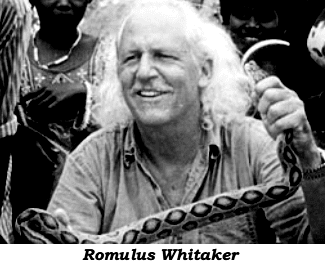 3. A mother's tolerance for a small boy's fascination with snakes became the basis of a notable career in herpetology for Whitaker. Author of eight books and over 150 articles, he served in key reptile posts and has inspired many with 23 acclaimed environmental documentaries, such as the National Geographic film "King Cobra". In 1984, for his project to help the indigenous Irula people of Tamil Nadu make the transition from their old trade (catching snakes for the now-banned skin trade) to collecting snake venom to produce life-saving anti-venom serum, he received an Honourable Mention in the Rolex Awards for Enterprise.
3. A mother's tolerance for a small boy's fascination with snakes became the basis of a notable career in herpetology for Whitaker. Author of eight books and over 150 articles, he served in key reptile posts and has inspired many with 23 acclaimed environmental documentaries, such as the National Geographic film "King Cobra". In 1984, for his project to help the indigenous Irula people of Tamil Nadu make the transition from their old trade (catching snakes for the now-banned skin trade) to collecting snake venom to produce life-saving anti-venom serum, he received an Honourable Mention in the Rolex Awards for Enterprise.
4. Whitaker realized long ago that snakes and the other species he loves cannot survive without their habitats. So, like many others, he has evolved from naturalist to conservationist. "A lot of us get wrapped up in our own little special animal and then we wake up and start thinking it has got to be habitat and it has to be eco-development that involves people and, now, in my case, it has crystallized into the whole idea of water resources.
5. "India has a history of droughts, floods and famines," Whitaker explains. "Food production has been successfully tackled and dealt with, but we are now faced with a water shortage that will dwarf any of the past problems faced by the people. Owing to forest clearance and ill-advised dam projects, rivers are drying up, ground water reserves are being used up faster than they can be replenished and pollution is hitting most of our sources of drinking water. These are the obvious problems, but there are other, possibly much more serious threats facing our water regimes including climate change, which we must tackle on a war footing."
6. Ironically, the water that Whitaker is intent on saving is - in the form of rain - one of the major obstacles to conservation research in many parts of India. Despite being recognized worldwide as biodiversity hotspots, relatively little is known about India's dwindling rainforests and the many species for which they are home. But monsoon downpours make it near-impossible for researchers to operate at the very time the most scientifically interesting events are occurring in the landscape and the lives of its inhabitants. At Agumbe, where Whitaker caught his first king cobra back in 1971, annual rainfall of 10 metres or so condemns outsiders not just to swarms of leeches, along with wet clothes and tents, but also to guaranteed malfunction in all the equipment bound up in recording, communicating and calculating.
7. Whitaker's base at Agumbe, constructed in 2005, and now a fully functioning research, conservation and education centre, is the first of seven research stations that will connect key remaining rainforest strongholds throughout India. Sita Nadi, a river that has its source near the Agumbe Station, is a major focus for Whitaker and his team, who have started a small but ambitious plan to clean up and maintain the integrity of the river, using a three-pronged approach: evaluating the problems, involving the people and implementing a practical action plan. Whitaker cannot emphasize enough the importance of the region's rainforests for water resources. "The rainforests of India are the origin of all the major rivers in the south and the north-east," he points out. "The rivers in the Western Ghats [in India's south] provide the water for 350 to 400 million people, about a third of India's population." 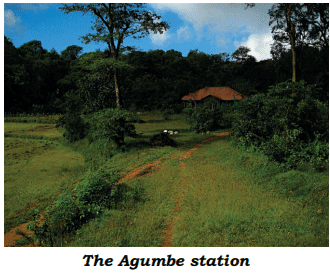 8. The Agumbe station itself consists of living and working quarters purposebuilt to function during the monsoon and to be self-sufficient in renewable energy. It is strategically located on about three hectares of land adjacent to a wildlife sanctuary and a national park so that field scientists have easy access to the forest. The base has hosted dozens of Indian researchers, journalists and naturalists. But the station's mission extends beyond science. It is a springboard for local conservation, including the sustainable use of minor forest produce and medicinal plants. The station has educated hundreds of school children about the forest. "Children are a bit shaky about going into the forest at first, but fascination with what we show them soon gets them hooked," Whitaker says.
8. The Agumbe station itself consists of living and working quarters purposebuilt to function during the monsoon and to be self-sufficient in renewable energy. It is strategically located on about three hectares of land adjacent to a wildlife sanctuary and a national park so that field scientists have easy access to the forest. The base has hosted dozens of Indian researchers, journalists and naturalists. But the station's mission extends beyond science. It is a springboard for local conservation, including the sustainable use of minor forest produce and medicinal plants. The station has educated hundreds of school children about the forest. "Children are a bit shaky about going into the forest at first, but fascination with what we show them soon gets them hooked," Whitaker says.
9. The network of seven stations will produce vital information, building on discoveries by Whitaker's colleagues of over 100 new species of frogs in the last decade, and the study of crabs that live in trees. The network will allow immediate exchange of expertise and research, creation of a comprehensive biodiversity database, and expanded mobile educational programmes. Five of the stations in the network, including Agumbe, will be located in the states that span the Western Ghats. A sixth station will be located in the far north-eastern state of Assam, a vital haven for large numbers of migratory birds and endangered mammals. The seventh station is in the Andaman and Nicobar Islands, situated 1,200 kilometres from the Indian mainland in the Bay of Bengal.
10. Six of the seven stations already exist in various stages of development and now need vital new laboratory equipment and in some cases physical expansion to bring them up to speed for the network. Whitaker will use the Rolex award to help make this happen. Only one station, near the Kalakkad-Mundanthurai Tiger Reserve in the southern tip of India, needs to be built from the ground up. The Rolex funds will also be used to fit out the bases with automatic weather stations. "Climate change is tightly linked with the future of water resources and we need to be monitoring it now," he says.
11. Whitaker puts his trust not just in his own skills, but also in the aspirations of younger generations: "We are doing a lot of work with young people, bringing them to the forest and showing them what happens here and why it matters. It can be very difficult to change adult attitudes, but with the young, it is easier to get across the knowledge that what we are doing to the forests, we are doing to ourselves."
A.2. The author of the article had made the following sub headings, but they got mixed up. Re-order them in the correct sequence, and write the number(s) of the paragraphs that would come under each sub heading.
- The network of rainforest research stations
- Whitaker's achievements
- People support
- Whitaker's love for nature, his vision and ambition
- The Agumbe station
- Water shortage and the need to save rainforests
- Becoming a conservationist
Ans: 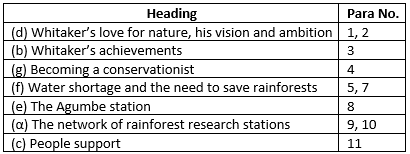
A.3. On the basis of your reading of the above article choose the correct option to complete the following statements:
1. Romulus Whitaker was able to pursue his dream because
a) he was determined
b) of his fascination with nature
c) he didn't have a regular job
d) he was sympathetic
2. Romulus's ambition was to
a) save reptiles and frogs
b) establish rainforest research stations
c) start a water conservation project
d) create awareness about the king cobra
3. Whitaker was able to fulfill his ambition with the help of
a) his friends and colleagues
b) Whitley award money
c) Rolex award money
d) his personal savings
4. Whitaker evolved from a Naturalist to Conservationist because he realized that
a) Naturalists get obsessed with animals
b) It was the requirement of Rolex award
c) Conservationist has more importance than naturalist
d) Animals cannot be saved without saving their habitat
5. According to Whitaker the most serious threat facing the humanity is
a) Forest clearance
b) Drying of rivers
c) Water shortage
d) Climate change
6. The mission of Agumbe research station is to
a) Educate children
b) Play host to Researchers, Journalists and Naturalists
c) Sustainable development of forest products
d) All the above
Ans:
1. (b) of his fascination with nature
2. (b) establish rainforest research stations
3. (b) Whitley award money
4. (d) Animals cannot be saved without saving their habitat
5. (c) Water shortage
6. (d) All the above
A.4. The dwindling forest cover not only threatens the habitat of millions of species but also endangers water reserves. On the basis of the above article and the visual input given, write a letter to the editor of a national daily expressing your concern about the threat to the bio reserves.
(a)
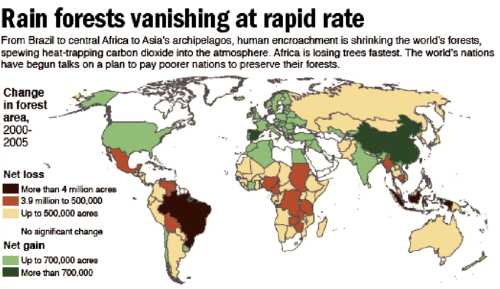
(b) Threat to animals Ans:
Ans:
15 L, Model Town
Rohtak
17 November, 20 – –
The Editor
The Daily Times
New Delhi
Subject: Dwindling forest cover—a threat to the bio reserves
Dear Sir
Kindly publish the following views of mine in the appropriate columns of your esteemed daily.
It is a fact that forest cover all over the world is fast dwindling. For instance, during 2000-2005 more than 4 million acres of forests disappeared ; 3.9 to 5,00,00 acres have also gone forever.
The dwindling forest cover resulted in a serious threat to various animals. For instance, 50% fish stand threatened. 20% of them are vulnerable to being endangered ; 10% endangered and 20% critically endangered. Amphibians, to the extent of 70%, are not endangered. But 30% of them do stand endangered. 12% of them are endangered ; 8% critically endangered and 10% are vulnerable to being endangered. Regarding reptiles, 60% stand endangered. 30% are vulnerable to being endangered, 17% are endangered and 13% critically endangered. 10% birds stand endangered and 25% mammals are threatened.
Dwindling forest reserves are a potent danger to food, fodder, timber, water etc. Soil erosion takes place. Flora and fauna disappears which causes the flow of water direct to the oceans and not into the ground. This doesn’t recharge the ground water table. Most importantly, there is a threat of droughts, famines etc, and scarcity of rain. Weather patterns have changed due to global warming. These effects have started showing their results in the form of climate change and consequent problems. This has forced the world countries to seriously think about conservation of forests and other means.
Forests are the sustainable sources of keeping biodiversity intact. So their disappearance means threat to humanity. Therefore, they need to be generated to rehabilitate the environment and ecosystem.
Yours faithfully
Bhupinder Singh
A.5. Romulus Whitaker has been awarded the Whitley Award for his work towards conservation of nature. He is in town for a press conference. Choose a student for the Hot Seat- to role play Whitaker. Divide the class into three groups; one group of students will be responsible for interviewing Whitaker. The second group will note down the interaction and the third group will issue a report for the class newsletter.
How to write a newspaper report
A report is a description of an event that has already taken place. It is a factual account of some event or happening that may have occurred somewhere but is of interest to the general masses or the readers for whom it is meant to be.
A newspaper report must be comprehensive but brief; factual yet interesting. Hence factual reporting is the accurate and truthful coverage of an event. It is a brief review of a situation or a process that includes only the relevant points and information. It is usually written in third person and indirect speech. Passive voice is used. The language is neutral and figurative. Ornamental language is avoided. The content should include when, where, why and how of the topic to be written about.
Headline
Every news article has a headline to attract the attention of the reader. The headline must state the topic of the news in a strong, short phrase or statement.
Headline must be:
- catchy
- brief - leave out articles, prepositions, etc where possible, use abbreviations/shortened word-forms wherever possible
Byline
Since this is your news article you need to let the reader know who wrote it. The line with your name on it is called "by" line because it tells by whom the article has been written.
Write the word "By" followed by your first and last name.
On the next line, write your School and City.
Paragraph 1
A lead paragraph usually answers the questions: Who? What? Where? When? Why? It tells the reader how the incident happened. Narrate the incident in the chronological order. Eyewitness accounts add to authenticity of the news. Also, they may interest the reader. Include some quotes from the eyewitnesses' comments. Also describe what they have felt about the incident.
Paragraph 2
Give details of the event. If it is an interview, use quotes from the interviewee.
Paragraph 3
Describe the future course of action being planned
Remember to use simple, clear but formal language
Aastha/ Anshul is the Secreatary of Green Fingers, the Environment Club of Gurukul School, Delhi. The school has celebrated Van Mahotsava on August 24. She/he has written a report of the programme for the school newsletter. As Aastha/Anshul write the report.
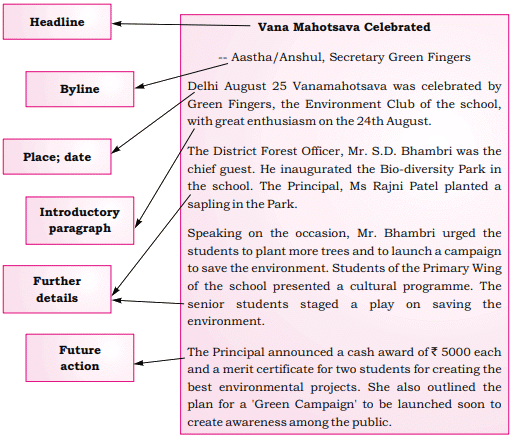 Ans: Classroom activity. Class is to be divided into three groups. One student to role play Whitaker. One group of students to interview Whitaker. The second group will note down the interaction (at this press conference). The third group to issue a report for the class newsletter.
Ans: Classroom activity. Class is to be divided into three groups. One student to role play Whitaker. One group of students to interview Whitaker. The second group will note down the interaction (at this press conference). The third group to issue a report for the class newsletter.
Students of one group to put the following questions to ‘Mr. Whitaker’.
I. Questions
- Well, Mr. Whitaker, what precisely has maae you a nature lover, say, an Environmentalist ?
- Mr. Whitaker, what has been your current ambition, ?
- What helped you set up the Agumbe Rainforest Research Station ?
- What has been your best environmental documentary ?
- What, Mr. Whitaker, made it possible for you to receive an Honourable Mention in the Rolex Awards for Enterprise and how did you use it ?
- Mr. Whitaker, what major problem did you envisage regarding water shortage, pollution and climate change ?
- Please elaborate on the plan behind these Research Stations at Agurnbe.
- Mr. Whitaker, how will your ambitious plan help in conserving the species inhabiting the rainforests ?
- How do you plan to cover the whole of the country through these Rainforests Research Stations ?
Thank you, Mr. Whitaker.
II. Answers (hints etc,) along with interactions to be noted by the second group.
- I would say that boundless enthusiasm for the wonders of nature and determination to save them has made me that. Actually the endless natural mysteries, wildlife and empathy and sympathy in the face of destruction have played a key role in my being so.
- (With a smile) to create a network of rainforest research stations throughout India— since long—but didn’t have the wherewithal—bought a block of land at Agurnbe in Southern India.
- The Whitley Award for Nature (helped a lot).
- I have authored eight books and over 150 articles. The best environmental documentary has been the National Geographic film ‘King Cobra’.
- I helped the Irula tribe people of Tamil Nadu to change over their traditional work of catching snakes to collecting snake venom to produce life-saving anti-venom serum. I spent the Whitley Award for Nature money in setting up these Research Stations.
- I saw that forest clearance and some dams resulted in the drying up of rivers. Ground water tables are getting lower. Pollution and climate change may soon create a great water shortage problem. Hence Rainforests Service Stations and their importance.
- It is to maintain Sita Nadi to evaluate the problems and involve the people in implementing the plan for augmenting water resources.
- These stations will produce vital information over 100 new species of frogs, crabs etc. There will be an exchange of expertise and research, creation of biodiversity database and mobile educational programmes.
- These stations are to be located in the Western Ghats ; one in the Assam and the next in the Andaman and Nicobar Islands.
Thank You Mr. Whitaker.
III. A Report by the third group :
Whitaker, the Pioneer of Rainforests Research Stations and Conservationist of Green Nature—A Report—by Praveen, Class XA, Spring Valley School, New Delhi
Romulus Earl Whitaker, a herpetologist, wildlife conservationist, founder of the Madras Snake Park, The Andaman and Nicobar Environment Trust, the Madras Crocodile Bank Trust and Rainforests Research Stations, is a famous name known to all nature lovers. In a Press Conference held tomorrow in our school he declared his dedication to preserving green nature to fight against the climate change, global warming and shortage of water.
With the help of various Awards like Rolex Funds and Whitley Award for Nature he has established Rainforests Research Stations in Tamil Nadu, Assam and the Andaman and Nicobar Islands to restore the depleting water reserves. His first station at Agumbe was a turning point for the Irula tribe people. They turned from snake catchers to helpers and contributors in the production of life-saving anti-venom serum.
His Rainforests stations in Tamil Nadu are not only research stations but institutions to teach the students biodiversity and how to preserve green nature to be a life-sustaining agency. In the press conference he told that these stations will produce vital information over 100 new species of frogs, crabs etc. These will also be an exchange of expertise and research creation of biodiversity database and mobile education programmes. Actually the climate change, global warming, greenhouse effect etc, made this herpetologist into an Environmentalist for whom life is like a big river.
Mr. Whitaker sees a bright future for restoring depleting water through these stations. He also sees it for educating the future generations about the essentiality of green nature for human and wildlife.
A.6. You are going to listen to an environmentalist giving a speech at a seminar on World Environment Day on ‘Wetlands, an important Ecosystem’. As you listen, complete the flowchart given below. 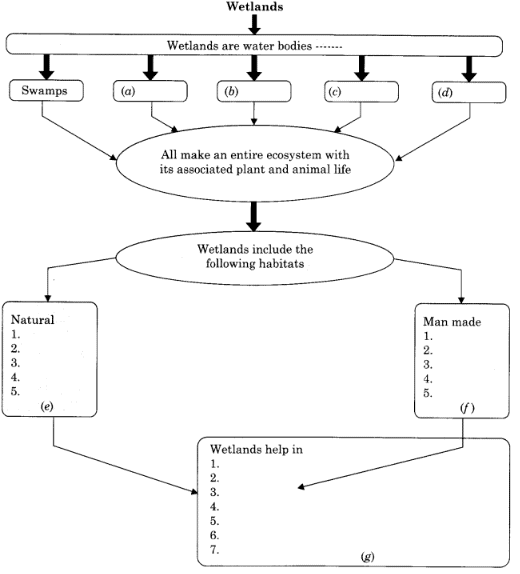
Ans:
(a) marshes
(b) oases
(c) mud flats
(d) paddy fields
(e)
1. rivers
2. lakes
3. lagoons
4. mangroves
5. coral reefs.
(f)
1. fish and shrimp farms
2. ponds
3. irrigated land like paddy fields
4. salt pans
5. reservoirs.
(g)
1. checking floods
2. preventing soil erosion
3. reclaiming land
4. breeding marine organisms like shrimps etc
5. preventing siltation of water ways
6. erosion of forests
7. providing the source of water.
|
8 videos|250 docs|8 tests
|
FAQs on Treading the Green Path- Towards Preservation NCERT Solutions - Communicative English for Class 10
| 1. What is the main focus of the article "Treading the Green Path- Towards Preservation"? |  |
| 2. How can individuals contribute to environmental preservation according to the article? |  |
| 3. What role do educational institutions play in promoting environmental awareness as mentioned in the article? |  |
| 4. What are some challenges to environmental preservation highlighted in the article? |  |
| 5. Why is it important to preserve biodiversity as discussed in the article? |  |





















